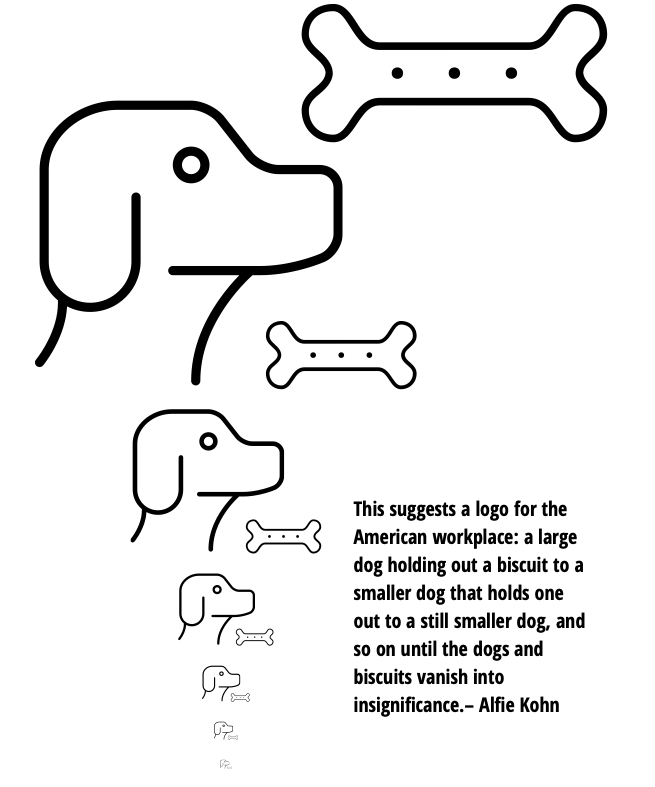Rewards and Motivation

"...all things being equal, we are less interested in doing things when we are made to feel like pawns. If we have very little discretion about what we do all day at work or school, there is a good chance we will spend the time wishing the weekend would arrive." – Alfie Kohn
😬 Behaviorism doesn't work
Our society and institutions sap away motivations through the use of behaviorism and rewards. Behaviorism was coined by B.F. Skinner, it describes the discipline of operant conditioning which could be used to manipulate and control others. Much of Skinner's work was on rats in boxes, conditioning them to have particular behaviors based on rewards. Much of this was translated to modern management theory, giving fuel to Taylorism and the cultural chasms in many large companies between management and labor.
Much of this stems from a simplistic assumption that rats and people share a lack of intrinsic motivations, so the company or firm must create an extrinsic motivational environment for them. However, when you mix extrinsic motivators with underlying intrinsic human interests, drives, knowledge, skills, and abilities, the use of extrinsic manipulations runs the real and measurable risk of replacing intrinsic motivations with extrinsic ones, undermining the real abilities and capabilities of your people.
🧠 How rewards can do harm
Alfie Kohn in his book Punished by Rewards, debunks much of Skinner's operant conditioning, demonstrating the real harm this reductionist way of thinking brings to organizations and communities. He finds through a meta-analysis of available research that Skinner's theories fall apart when used on humans when looked at long-term they actually backfire and cause significant harm, and cheapen humanity's intrinsic motivations and abilities. They can be initially effective and show promise, but when considering the sustained behavior changes from the conditioning, the conditioned individual can become resistant to conditioning unrelated to the activity. Worse, the replacement of intrinsic motivations with extrinsic ones can have negative consequences.
He uses an example of a child getting pizza vouchers from their local library for reading books in a summer reading program. Pizza becomes the extrinsic reward, wholly unrelated to the activity at hand, reading. This kind of candy for positive behavior initially works, but as time goes on research has again and again demonstrated, that a disconnect between the reward, and the activity creates an overall demotivation. Over time, the pizza reward has no influence on reading, and in fact can change reading to be reward-seeking, causing readers to seek shorter books, or easier books in order to justify the reward.
“Our sense of ourselves as basically competent and worthwhile, of being able to have an impact on the events that shape our lives—in short, our mental health—is in jeopardy when extrinsic motivation displaces intrinsic.” – Alfie Kohn
🏆 How to make rewards work
In his book, he suggests some ways that we can continue to use rewarding structures, but with intentionality and connection to the actual behavior or action, we want to encourage. This kind of rewarding structure seeks to reinforce the intrinsic motivation, not remove and short-circuit it.
He suggests that we:
- Get rewards out of people's faces
- Offer rewards after the fact, as a surprise
- Don't turn the quest for rewards into a contest
- Make the reward as similar to the task as possible
- Give people choice about how rewards are used
- Try to immunize people against the motivation-killing effects of rewards
🏢 Rewards done wrong in the workplace
Workplace motivators are often considered at a firm-level, which necessarily means they cannot be specific or related to actual work or the intrinsic motivations of the worker.
“The evidence, however, suggests that extrinsic motivators in the workplace are not only ineffective but often positively counterproductive. [...] The bottom line is that any approach that offers a reward for better performance is destined to be ineffective.” – Alfie Kohn
He goes on to paint a visual that demonstrates that the race to reward at all levels of the hierarchy creates a zero-sum game and race to the bottom in terms of actual motivations. Suggesting that the logo for corporate America should represent a large dog and dog biscuit for the leader, a smaller biscuit, and necessarily a smaller dog down the line, onward until the last dog and biscuit are infinitesimally small. The motivations in the modern financialized firm become about the reward structures, full stop.

How do you motivate others you work with, is your feedback specific and relevant to the work they do?
Are there inventive structures in your workplace you find demotivating?
What could you do to change these structures based on the suggestions above?
Does your workplace use "merit-based pay increases"? What are the ways in which "merit" is evaluated and compared? Are these helpful or motivational?
📖 Further Reading

If you've enjoyed this article, are looking to build a learning organization, or otherwise grow the resilience and competency of your team, please reach out. I love to hear from you.
I help teams consider their collective capabilities, future visions, and strategies for building impact-driven organizations which can co-create a rich and resilient future. This work starts with understanding your people, how you work today, and what you aspire to. With facilitated conversations about how you work with your people to collectively reach your goals.

Member discussion